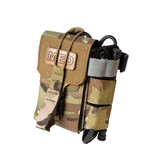Essential Items to Carry in a Med Kit: What You Really Need
When it comes to responding to life-threatening injuries, having the right gear in your med kit can make all the difference. Our med kits are not your everyday first aid kit— they are specifically designed to save lives in critical situations involving traumatic injuries. To avoid overcomplicating things or wasting precious time, it's important to carry only the essentials. Here's what you should include and why.
The Most Important Items in Your Trauma Kit
- TourniquetA tourniquet is a must-have for stopping life-threatening bleeding, especially in the limbs. The C-A-T and SOF® Tourniquetare two of the best options available. If properly applied, a tourniquet can save a life by stopping the flow of blood to a severely injured limb. Just make sure your tourniquet is accessible, made by a reputable manufacturer and is backed by evidence of efficacy—never rely on knock-offs.
- Gauze (Hemostatic and Sterile)Uncontrolled bleeding is the leading cause of death due to trauma. Wounds may occur at junctions of the body where tourniquets cannot be placed. Hemostatic gauze is designed to stop severe bleeding quickly. QuikClot, for example, contains agents that promote clotting, helping to stop the flow of blood until further medical treatment is available. This is an essential item for managing serious wounds where blood loss occurs quickly. If you are not trained or do not yet have the budget for hemostatic gauze, simple sterile gauze is still very effective.
- Chest SealChest injuries, particularly those that result in an open chest wound (like a gunshot or stab wound), can lead to life-threatening complications, including a collapsed lung. A chest seal is a simple, adhesive device designed to close these wounds and prevent air from entering the chest cavity, buying precious time for the injured person.
Keep It Simple
One of the most common mistakes people make when building a med kit focused on trauma is packing it full of unnecessary items. Remember, a trauma kit has one purpose: to save lives. This is not the place for band-aids or everyday items like pain relievers—those belong in a standard first aid kit. Keeping your trauma kit simple ensures that, in an emergency, you can quickly find and access the tools you need without wasting time. For those that would like all of their medical items in one place, having your “illness and minor injury” items in a totally separate compartment is recommended.
Additional Items
We have discussed the “work horse” or what we call the milk, eggs, and flour of a med kit. Some other items that may be considered as valuable additions include bright colored nitrile exam gloves for protection and precaution, a pressure bandage and tape to secure your gauze, and trauma shears, as some clothing made need to be safely cut away to effectively find and treat injuries.
Always Keep It Handy
Having the best med kit in the world won't help if it's not easily accessible. It’s critical that your kit is close at hand, not buried in the trunk of your car or stuffed away in a bag somewhere. In trauma situations, it only takes seconds to bleed out. The faster you can get to your kit, the better your chances of saving a life. Carry your kit somewhere easily reachable, like in your vehicle's cabin or attached to your gear.
Know How to Use It
Having the right tools is just half the battle—you also need to know how to use them. Trauma care skills require training and practice. It's important to familiarize yourself with each item in your kit and practice using them so that, when a real emergency strikes, you're prepared to act swiftly and effectively. There are plenty of resources, from online tutorials to hands-on courses, and “training versions of kit items” that can help you master these life-saving techniques.
Conclusion
A well-stocked and easily accessible med kit could be the difference between life and death in an emergency. The most essential items are a tourniquet, hemostatic gauze and a chest seal. Keep your kit simple, focused on the tools that will save lives, and ensure it's always within reach. Above all, make sure you know how to use everything in your kit—because when the moment comes, there's no time for second-guessing. Stay prepared, stay trained, and keep it simple.
Explore Popular Articles
Why Every Law Enforcement Officer Should Carry a Medical Kit
In high-risk professions like law enforcement, seconds can mean the difference between life and deat...
The New Eleven 10® Responder MINI IFAK
Meet the New Eleven 10® Responder MINI IFAK: The Best IFAK for 2025 At Eleven 10® (E10), we design g...
Compressed Gauze vs. Hemostatic Gauze
The Efficacy of Compressed Gauze vs. Hemostatic Gauze in Controlling Uncontrolled Hemorrhage Unco...
Why Investing in a Quality Tourniquet Could Save Your Life
When it comes to emergency medical gear, there’s one tool that stands above the rest for saving live...

